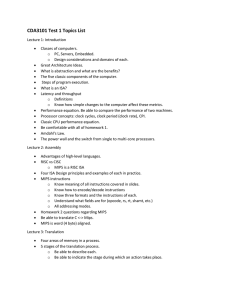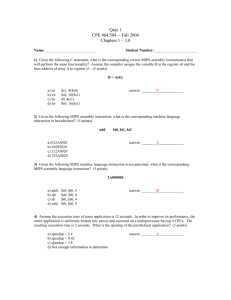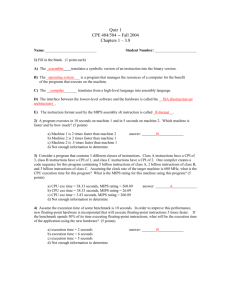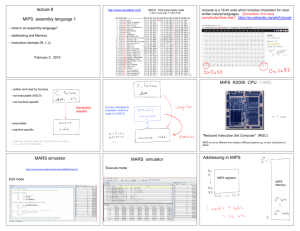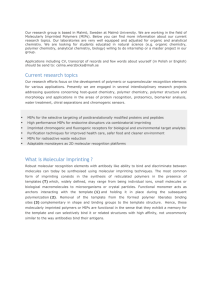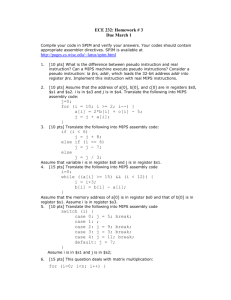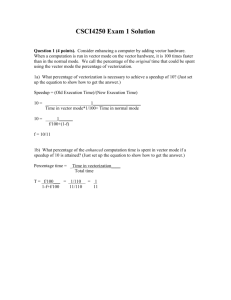Mid-semester Practice Problems
advertisement
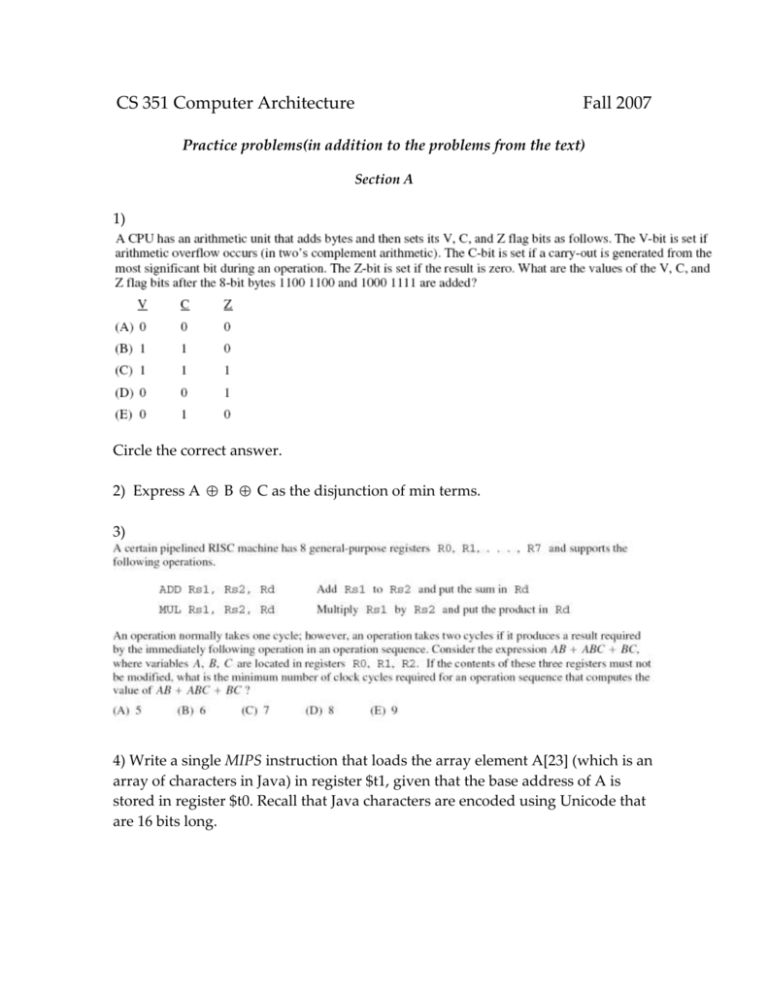
CS 351 Computer Architecture Fall 2007 Practice problems(in addition to the problems from the text) Section A 1) Circle the correct answer. 2) Express A B C as the disjunction of min terms. 3) 4) Write a single MIPS instruction that loads the array element A[23] (which is an array of characters in Java) in register $t1, given that the base address of A is stored in register $t0. Recall that Java characters are encoded using Unicode that are 16 bits long. 5) What is the maximum number of R-type, I-type and J-type instructions that a MIPS instruction set can have, assuming the standard encoding described in the text? 6) What is the range of address for conditional branches (e.g. using the instruction beq) in MIPS? Circle the correct answer. (a) addresses between 0 and 64 K – 1 (b) addresses between 0 and 256 K – 1 (c) addresses up to about 32 K before the branch to about 32 K after (d) addresses up to about 128 K before the branch to about 128 K after 7) Which of the following are necessary conditions for overflow when two integers A and B (in two’s complement) are added? (a) A < B < 0 (b) both A and B have the same sign. (c) the sign of the sum (added as unsigned integers) is different from that of at least one of the operands. (d) either A or B is a string of 1’s Circle the correct answer: (1) a and b only (2) b and c only (3) b only (4) c and d only (5) none of them. 8) Write a single MIPS instruction that sets the register $t0 to 1 (0) according as the most-significant bit of $t1 is 1 (0). 9) 10) Write a code segment in MIPS assembly language that sets $t0 to 1 (0) according as the big-endian (little-endian) notation used by the memory system. 11) Write a formula that connects the quantities clock speed = c GHz/ sec, the average number of cycles/instruction = a, the size of the program = p (expressed as the number of instructions) and the time to execute the program = t expressed in seconds. 12) State Amdahl’s law relating the quantities s = speed-up, f = the fraction for which the speed-up does not apply and p = the factor of speed-up for the fraction that can be speeded up. Section B practice problems 1) (a) What does the MIPS procedure do? proc:move $v0,$a0 blt $a0,2,done li $t0,0 li $v0,1 loop: add $t1,$t0,$v0 move $t0,$v0 move $v0,$t1 sub $a0,1 bgt $a0,1,loop done: jr $ra (b) Write an expression for the number of instructions executed by the above procedure when called with $a0 = 25. 2) (a) Write a recursive procedure binomial(n,m)(in C) where n and m are 32 n bit positive integers to compute the binomial coefficient using the formula m n n 1 n 1 . Make sure that you provide appropriate exit conditions. m m m 1 You can assume that the result is a 32 bit integer. (b) Translate your C code for binomial(n,m) into MIPS assembly language. (c) For m = 10, what is the largest value of m such that binomial(n,m) will fit in a 32-bit register? 3) Design a circuit that takes 8 input bits b1 b2… b8 and outputs the binary representation of b1 b2… b8 +1. For example, on input 1011 0011, the output should be 1011 0100. (When all the input bits are 1, the output should be 0000 0000. (i.e., overflow is ignored.) 4) A computer manufacturer offers two types of systems. The high-end system comes equipped with a floating-point coprocessor while the low-end processor (without the coprocessor) uses integer-based software routines to perform the floating point operations. Both systems use a 20MHz processor. The high-end system has a CPI of 10 and takes 1 second to run a benchmark program, whereas the low-end system has a CPI of 6 and takes 10 seconds for the same task. (Assume that 40% of the instructions in the bench-mark run on the high-end system are floating-point instructions.) a) What is the MIPS (Million Instructions Per Second) rating of the two systems? b) What is the total number of instructions executed in both cases? c) On average, how many integer instructions does it take to simulate a floatingpoint operation in the low-end system?

